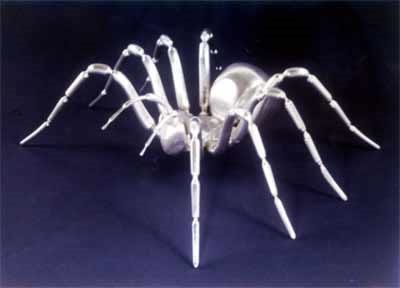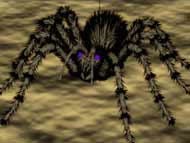The Story of Boris
Have you ever wondered about the origins of Delcam's spider logo?
Most of our readers are familiar with Delcam, a leading supplier of CAD/CAM solutions for manufacturing including PartMaker, FeatureCAM and PowerMill. The company’s product logos are easily recognizable as they incorporate a CAD-rendered spider named Boris. But what is the origin of this arachnidian model and how did it become a manufacturing software icon?
In 1984 Jon Hunwick joined Delcam (or Delta CAE, as it was known then) as technician to the DUCT Development Unit in Cambridge. After an initial training period learning how to do routine tasks such as making sure the PRIME 250 computer started up every morning and creating backup tapes (reel-to-reel!) of all the previous days’ work, he was approached one morning by David Sturge with a copy of the DUCT 4.2 manual and some brief training notes. David simply said, “Learn this.”
At about the same time, Gavin Miller (www.doctorgavin.com) joined the unit as a post-graduate student working on advanced ray-tracing. A massive Sigma frame-store was brought in to the department for Gavin to use, but it required huge amounts of processing power. Gavin found himself having to work overnight most of the time so he did not have to share computer time, instead, having the 250 all to himself.
As well as producing some interesting “mechanical” effects, lighting, shadows, reflections, and so on, Gavin was particularly interested in natural phenomena, such as rippling water, fractal landscapes and, especially, hair (being somewhat challenged in that department himself). After successfully creating the effect of fuzzy dice, Gavin was looking for a more interesting challenge, but what?
The answer came at about 2:30 one Tuesday morning. A large, and exceptionally hairy spider fell from the ceiling, landed on his keyboard, and then nonchalantly lowered itself to the floor before disappearing under the skirting board. As it progressed across the floor it grew bigger in Gavin’s mind until, to his imagination at least, it appeared the size of a small dog.
The next morning, when Jon arrived, Gavin asked him to make a spider in DUCT. “You can’t be serious,” Jon retorted.
“Yes, I can,” said Gavin. “It will be fun, and then I can render it all furry.”
About an hour later, Gavin disappeared into the town center and returned with a wooden toy spider. This was made of flat sheets of pre-cut plywood that could be slotted together to form a 3D model. Jon took all the individual pieces and traced them onto graph paper. During the next couple of days, the coordinates were transferred into DUCT, and slowly, Boris took shape.
Gavin then set to work and produced some spectacular images. But not satisfied with simply being able to create fancy pictures, another part of Gavin’s work was to create DUCT’s first multi-surface machining algorithms by using a technique called Z-buffering. Jon worked out how to machine and assemble the legs and pedipalps (antenna-like appendages) onto the main body, and the finished model was cut on the university’s Bridgeport Series 1 CNC milling machine.
About a month later, Jon took the metal Boris to an exhibition in London. Managing Director Hugh Humphreys visited the show for a day, immediately fell in love with Boris and decided to take him back to Birmingham to make him the company mascot.
Since then, Boris has become the official Delcam logo, and hundreds of metal versions, in differing scales, have been produced. He has also been seen in STL format, and some rapid prototyping machine vendors even issue an STL version with each new machine.
The only remaining question is where the name “Boris” came from. Well, the answer is very simple. About the same time that Boris was created, the rock band The Who released a song called “Boris the Spider.”
Related Content
Mastercam Software Improves Programming Flexibility
IMTS 2024: Mastercam introduces Mastercam 2025, with features including Mastercam Deburr for automated edge finishing, finish passes, mill-turn support for Y-axis turning and automatic license update notifications.
Read MoreLone Shop Machinist Benefits From Five-Axis CAM Modules
This California shop owner applies five-axis strategies for more efficient milling of parts with challenging geometries, free-form surfaces and deep cavities.
Read MoreIntegrated CAD/CAM Software for Maximum Efficiency
PMTS 2023: This software solution is said to enable users to take advanced mill-turn and Swiss-type machining to new levels of speed, efficiency and simplified programming.
Read MoreThe Value of CAD/CAM and Cutting Tool Manufacturers Working Together
Overall machining efficiency can be increased when software and tooling companies combine to tackle machining challenges.
Read MoreRead Next
Emerging Leaders Nominations Now Open
Here’s your chance to highlight a young person in your manufacturing business who is on the path to be a future leader moving your company forward.
Read More5 Aspects of PMTS I Appreciate
The three-day edition of the 2025 Precision Machining Technology Show kicks off at the start of April. I’ll be there, and here are some reasons why.
Read MoreDo You Have Single Points of Failure?
Plans need to be in place before a catastrophic event occurs.
Read More









.jpg;maxWidth=300;quality=90)















